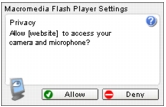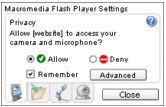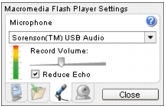

  | |
Flash Player 6.
Microphone.get([index])
Note: The correct syntax is Microphone.get(). To assign the Microphone object to a variable, use syntax like active_mic = Microphone.get().
index An optional zero-based integer that specifies which microphone to get, as determined from the array that Microphone.names contains. To get the default microphone (which is recommended for most applications), omit this parameter.
index is not specified, this method returns a reference to the default microphone or, if it is not available, to the first available microphone. If no microphones are available or installed, the method returns null.index is specified, this method returns a reference to the requested microphone, or null if it is not available. Method; returns a reference to a Microphone object for capturing audio. To actually begin capturing the audio, you must attach the Microphone object to a MovieClip object (see MovieClip.attachAudio()).
Unlike objects that you create using the new constructor, multiple calls to Microphone.get() reference the same microphone. Thus, if your script contains the lines mic1 = Microphone.get() and mic2 = Microphone.get(), both mic1 and mic2 reference the same (default) microphone.
In general, you shouldn't pass a value for index; simply use the Microphone.get() method to return a reference to the default microphone. By means of the Microphone settings panel (discussed later in this section), the user can specify the default microphone Flash should use. If you pass a value for index, you might be trying to reference a microphone other than the one the user prefers. You might use index in rare cases—for example, if your application is capturing audio from two microphones at the same time.
When a SWF file tries to access the microphone returned by the Microphone.get() method—for example, when you issue MovieClip.attachAudio()— Flash Player displays a Privacy dialog box that lets the user choose whether to allow or deny access to the microphone. (Make sure your Stage size is at least 215 x 138 pixels; this is the minimum size Flash requires to display the dialog box.)

When the user responds to this dialog box, the Microphone.onStatus event handler returns an information object that indicates the user's response. To determine whether the user has denied or allowed access to the camera without processing this event handler, use Microphone.muted.
The user can also specify permanent privacy settings for a particular domain by right-clicking (Windows) or Control-clicking (Macintosh) while a SWF file is playing, choosing Settings, opening the Privacy panel, and selecting Remember.

If Microphone.get() returns null, either the microphone is in use by another application, or there are no microphones installed on the system. To determine whether any microphones are installed, use Microphones.names.length. To display the Flash Player Microphone Settings panel, which lets the user choose the microphone to be referenced by Microphone.get(), use System.showSettings(2).

The following example lets the user specify the default microphone, then captures audio and plays it back locally. To avoid feedback, you may want to test this code while wearing headphones.
System.showSettings(2); myMic = Microphone.get(); _root.attachAudio(myMic);
Microphone.index, Microphone.muted, Microphone.names, Microphone.onStatus, MovieClip.attachAudio()
  | |